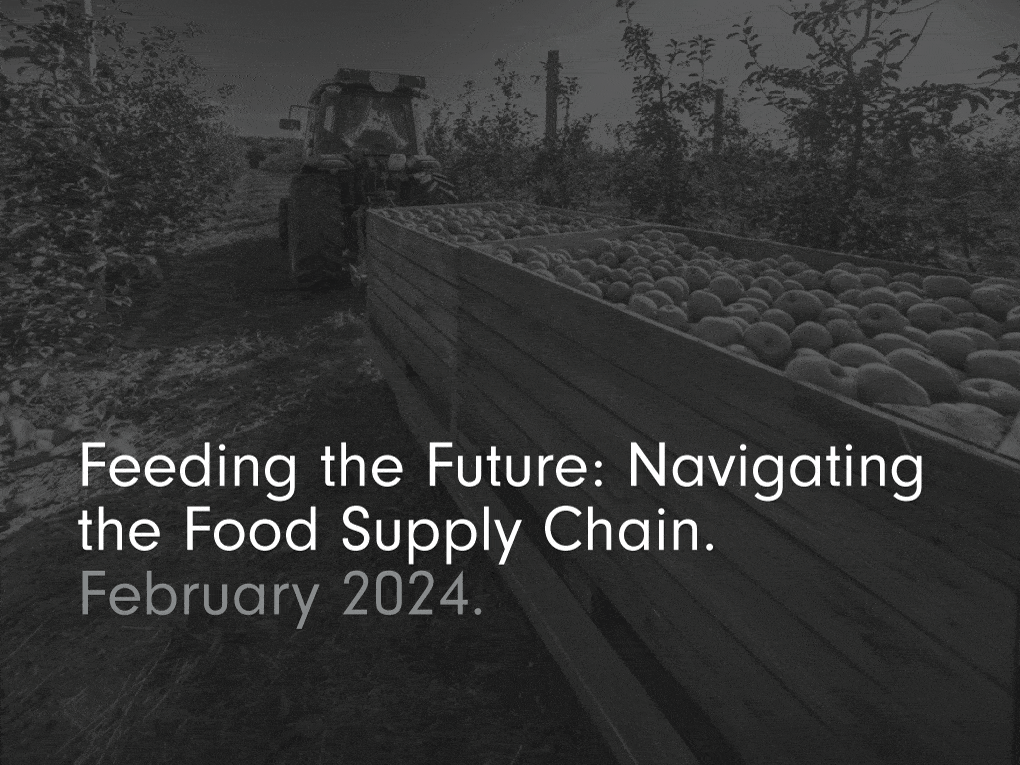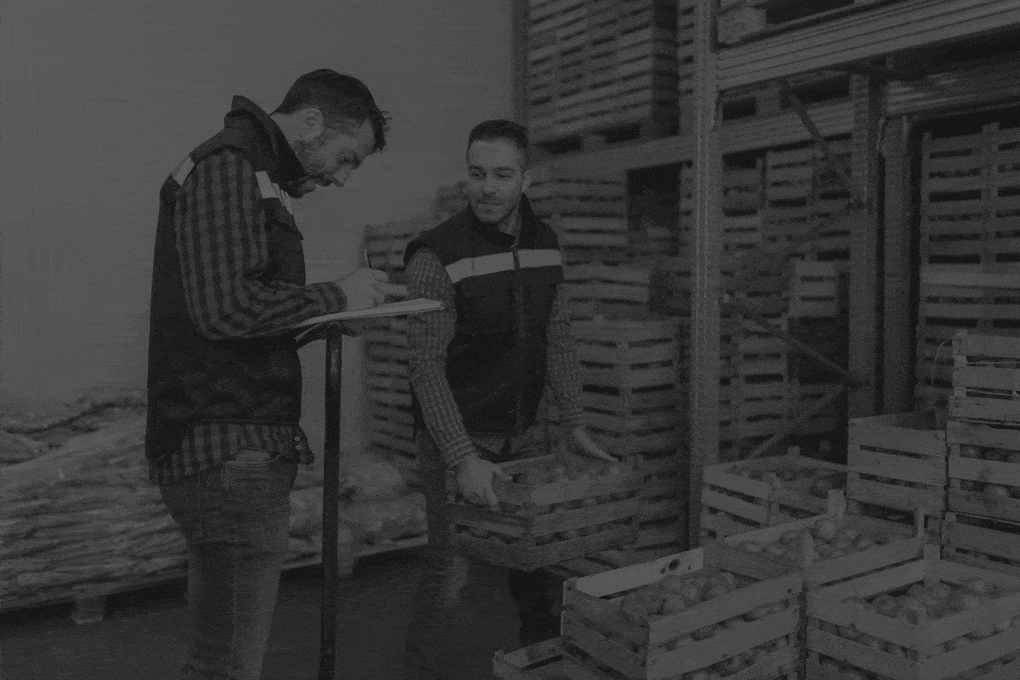The Food Supply Chain in 2024.

The food supply chain has recently been tested like never before. The effects of Brexit and the widespread disruption brought by the pandemic significantly impacted the industry. Plus, we have seen extreme weather events that have devastated crops, geopolitical conflicts and wars that have affected supplies and inflation and a cost-of-living crisis that have only added to the strain.
It’s clear that the past few years have been particularly trying for the industry, leaving those in the food supply chain grappling with a number of challenges that have strained resilience.
As a company with many clients deeply ingrained in the food supply chain, we recognise the importance of understanding these challenges and the impact they have on the companies we work with. Not only is the food supply chain a vital network of production and distribution, but it is also the backbone of our society when it comes to providing nourishment and wellbeing.
The repercussions of these issues have drawn claims that the UK’s food supply chain is fundamentally compromised.
Whether this is the case is addressed by the 2024 report from the Oxford Farming Conference (OFC), Is Our UK Food Supply Chain Broken? The OFC Report 2024 is based on extensive interviews and qualitative data. It offers insights into the experiences of farmers, growers, packers and retailers, providing a comprehensive analysis of the UK food supply chain.
The report considers the roles of all players in the sector, including the UK government and non-governmental organisations. It raises a number of key points and offers recommendations for improvements to the food supply chain.
Here, using data and analysis from the OFC Report, we examine the state of the food supply chain in 2024.
The current landscape of the UK food supply chain.

The pre-existing weaknesses in the food supply chain have been exacerbated by the problems and challenges we’ve experienced over the past few years.
According to many, this has resulted in a broken food supply chain. For these commentators, the fault lies with the retailers. But the food supply chain consists of many parts, all of which have a hand in shaping its current state and future prospects. As well as the retailers, there are the farmers and growers, plus those that regulate and influence the sector, such as the government and various NGOs.
While it’s not clear whether the food supply chain is broken, it’s certainly volatile. Political turmoil at home and abroad, plus continuing economic uncertainty and instability will present significant difficulties in 2024. This is predicted to affect economies, with the results being increased prices and reductions in production, investment and consumer expenditure.
All of this will further stress the food supply chain, necessitating a re-evaluation of approaches within the sector.
Farmers and growers in the food supply chain.

The Curry Report of 2001 highlighted critical areas for improvement for farmers and growers in the food supply chain. The report emphasised the need for farmers to listen to their customers, enhance their marketing skills, collaborate effectively and understand their business more comprehensively.
Despite the passage of more than two decades since then, there remains a question about whether farmers and growers have evolved in their understanding of their business.
Three themes are prevalent in the market: unprecedented levels of risk for farmers and growers, the prevalence of oversupply and the lack of understanding of the costs of production.
Lots of risk, little reward.
For farmers and growers, risks have reached unprecedented levels, without the corresponding levels of reward. This is particularly challenging given the substantial upfront costs many have to bear, which in some cases – like with certain fruit crops – may not yield any financial return for as long as seven years. This prolonged period between initial investment and potential profit exacerbates the financial vulnerability and uncertainty they face in an already precarious market.
For those that grow produce with a short shelf life, they need to pick and despatch it very rapidly, otherwise there is a risk that it will spoil before it can be sold. Here, once again, all the risk lies with the grower.
There are different risks and timescales associated with different produce, whether its livestock or fruit and vegetables. But despite these differences, buyers tend to treat products similarly and will work on fixed-price, annual contracts. This reveals another issue, which is the lack of understanding of the risk, costs and input that is required of farmers and growers.
Volatile weather patterns have presented significant risks in some areas, particularly those affected by flooding. While previously growers would have planted in excess of needs, high costs now prohibit this. So, any damage to crops will seriously impact a grower’s potential income. It’s not a risk that many are prepared to take. Essentially subsidising the cheap food that consumers are demanding is costing them too much and they are leaving the sector or changing their focus.
For many producers, their labour costs represent more than half of their expenditure. Rapidly rising wages have significantly eroded their profit margins, often leading to financial losses.
There is also a growing challenge in securing skilled pickers. This shortage not only hampers harvest efficiency but also affects the quality and quantity of produce reaching the market.
With a squeeze on profitability from all sides, many producers have major concerns, which will continue to challenge the sustainability of their operations in the 2024 economic climate.
The consequences of agricultural oversupply.
While we have seen shortages of certain goods over the years, in some sectors the food supply chain has experienced significant overproduction. This trend can be attributed to various factors, including advancements in farming practices and technologies. This has seen farmers and growers become increasingly efficient as they continually strive to improve production techniques. This dedication to growth is so ingrained that when one farmer or grower leaves the industry, their production volume is usually absorbed by another, and actually results in abundance rather than scarcity.
As an example, the soft fruit industry has seen a remarkable 600% growth over the past 25 years. Innovations have extended the UK growing season, leading to an oversupply. This oversupply consequently caused buyers to demand lower costs.
Challenges such as Brexit, labour shortages, soaring costs and inflation have impacted the sustainability of production in the UK. Despite oversupply and increased UK production of some crops, price pressure has reduced the competitiveness of some UK produced goods. So, despite a growth in soft fruit production, we still only produce around 15% of the fresh fruit we consume. So, we still import a significant amount of – cheaper – fresh produce.
With production costs not being met by the returns, many growers have found themselves in deficit, leading to a reduction in investment or a complete exit from the sector.
The importance of cost awareness.
Farmers and growers have a tendency to overlook the importance of understanding the full cost of production. This prevents them from making a fair return on their produce. While the focus traditionally has been on enhancing agricultural productivity, the report found that many in the sector lack a comprehensive understanding of their financials.
There is also a mindset that growing more is better. This is often driven by government policies aimed at delivering cheap food and has led farmers to accept retail offers without fully understanding the likely impacts to their business.
This approach has set a precedent for retailers, who have continued to base their pricing expectations on those initially accepted subpar offers. But those growers and farmers that do not fully understand their production costs cannot possibly comprehend if a potential venture or offer is financially viable.
There is a lack of a cohesive approach in the agricultural sector, with many small-scale producers. This has resulted in competitive disadvantage as some farmers have adopted a waiting strategy, hoping to gain market share as competitors exit the industry.
However, the fragmented nature of the industry, combined with a focus on higher volume at lower profit margins, makes it vulnerable to retail pressures. The consequence in some categories has been that retailers have simply turned to overseas suppliers.
With the emergence of alternative, less risky ventures – such as renewable energy – many producers have been attracted by the more stable returns they can achieve, without the high capital costs associated with traditional farming.
Retailers in the food supply chain.

Retailers play a crucial role in the food supply chain. According to Kantar figures for last year, the main supermarket chains held a massive 97.7% of the grocery market share.
But blaming retailers alone for the issues in the sector is an oversimplification. After all, suppliers need the retailers to sell the goods for them. However, for the food supply chain to remain strong, this relationship relies on consistency and fairness.
Unfortunately, with some supermarkets, there is a disconnect between how its executives stress the importance of strong relationships with suppliers – and how their buyers manage those suppliers.
Buyers are focused almost exclusively on price. In the context of the current cost of living crisis, this is understandable. But suppliers too are subject to the effects of that crisis. And the relentless single-minded approach to buying is unbalancing the already fragile market.
Trust in the food supply market has been eroded. Suppliers have very limited power in negotiations and feel they are in an unfair position when dealing with the might of the retail chains.
To restore some measure of order to the food supply chain, behaviours and attitudes will need to change – for all parties.
Three areas in particular have squeezed suppliers’ profit margins over the past decade: fixed price long-term contracts, inexperienced buyers and the burden of audits.
Detrimental fixed price long-term contracts.
The transition from a trading model based on short-term supply and demand to long-term fixed price contracts has had a detrimental impact on the food supply chain in some sectors, particularly produce.
This model places significant risk on the growers and farmers, especially during times of volatility. It was originally adopted by some German retailers when volumes were low. This fixed price model was manageable for growers and suppliers as there was limited risk and specifications were less restrictive. However, the practice has become more widespread as buyers have moved between retailers, taking it with them. And now that volumes have increased, the model is increasingly damaging for growers and farmers. While the previous model spread risk across parties, this new model burdening the suppliers with the whole risk.
In the UK, this fixed price model often leads to contracts that span an entire growing season or more. While this approach can be effective in stable economic conditions with low inflation and interest rates, it becomes problematic when there is more volatility. By contrast, the European produce market typically operates on a supply-and-demand model with pricing that is more flexible, often being adjusted weekly or monthly. This allows for better responsiveness to market conditions…
Want to read more?
Download for insights and recommendations
Download the Food Supply Chain in 2024 Whitepaper.

- Dive into an in-depth analysis of the UK food supply chain
- Understand the vulnerabilities faced by farmers, retailers and suppliers
- Get valuable strategies for a stronger supply chain